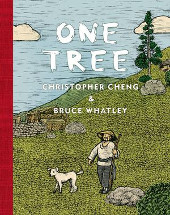One tree by Christopher Cheng

Illus. by Bruce Whatley. Puffin, 2019. ISBN: 9780143786733.
(Age: 4+) Highly recommended. Themes: Environment, Change,
Urbanisation, China, Gardens. A boy who lives in an apartment in a
city is saddened that his Grandfather who lives with them rarely
speaks; his father has told him that this man was always full of
stories, particularly about his farm where he lived beneath a large
tree.
The boy knows well the story of the old man, taking his produce to
the village market, where if someone asked where he lived, he
proudly pointed to the large tree on the hill.
But now the crowded apartments block the old landscape, and he is
unhappy, looking only at a picture on the wall of his farm. But a
chance sighting of a small seedling growing in the footpath gives
the boy and his grandfather a way of communicating, a way to talk to
each other, one to tell his stories and teach the younger child, the
boy to listen and learn from his grandfather.
Christopher Cheng's heritage gives a resounding strength to this
wonderful story of youth and age, of change and adaptation. The
apartment houses represent a new way of life, one that the old man
finds hard to accept, remembering instead the open fields and hills
where he once lived. His memories come back when the boy brings home
the seedling, Grandfather gradually becoming involved in the growing
of the seedling, buying soil and a pot, telling the boy he must talk
to his tree, leave it on the balcony for warmth and sunlight, and
bring it in at night against the cold. The two sit together as their
plant multiplies, and the boy is proud when they can go to the
market and look up and recognise their flat by searching for the
green on the balcony. Sharing the seedlings means others put pots on
their balconies and the small act by one boy stimulates others in
his neighbourhood.
Whatley's masterful illustrations, using new techniques which
reference ages old lino and woodblock printing, will engage the
readers as he contrasts their lives. The life of the older man on
his farm, with his life today in the crowded city, the boy's life,
swamped by rows of moving feet on the footpath with Grandfather's
lone years tending his land. The images evolve through the story,
showing a reclusive old man becoming one who is engaged and
communicating, the landscape once open and forested to one filled
with apartment blocks, a boy who is puzzled to one who is rapt in
the attention of his grandfather. Poignant and evocative, Whatley's
detailed illustrations will remain with the reader as they close the
last page and think about the boy and his family.
This is a beautiful testimony to the place of older people within a
family, the wisdom they can pass on, the changes they have seen and
their evolving relationships with the younger generation. Cheng
inhabits his story with an almost mythic quality; it is like reading
a fable which readers will ponder long after the story has finished.
Teacher's
notes are available.
Fran Knight